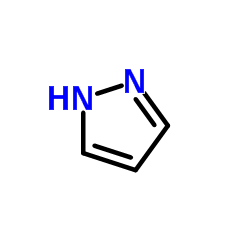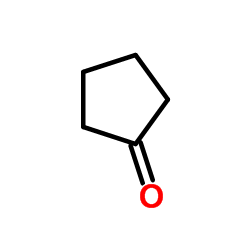1,1'-cyclopentylidenebis-1H-pyrazole
Modify Date: 2025-08-27 07:35:22

1,1'-cyclopentylidenebis-1H-pyrazole structure
|
Common Name | 1,1'-cyclopentylidenebis-1H-pyrazole | ||
|---|---|---|---|---|
| CAS Number | 28791-87-9 | Molecular Weight | 202.25600 | |
| Density | N/A | Boiling Point | N/A | |
| Molecular Formula | C11H14N4 | Melting Point | N/A | |
| MSDS | N/A | Flash Point | N/A | |
| Name | 1-(1-pyrazol-1-ylcyclopentyl)pyrazole |
|---|---|
| Synonym | More Synonyms |
| Molecular Formula | C11H14N4 |
|---|---|
| Molecular Weight | 202.25600 |
| Exact Mass | 202.12200 |
| PSA | 35.64000 |
| LogP | 1.85470 |
| InChIKey | USFLKKPBLJPJRJ-UHFFFAOYSA-N |
| SMILES | c1cnn(C2(n3cccn3)CCCC2)c1 |
Synonym:1,1-Cyclopentylidenebis-1H-Pyrazole Section 2 - COMPOSITION, INFORMATION ON INGREDIENTS
Risk Phrases: 23/24/25 36/37/38 Section 3 - HAZARDS IDENTIFICATION EMERGENCY OVERVIEW
Toxic by inhalation, in contact with skin and if swallowed. Irritating to eyes, respiratory system and skin.The toxicological properties of this material have not been fully investigated. Potential Health Effects Eye: Causes eye irritation. May cause chemical conjunctivitis. Skin: Causes skin irritation. Toxic in contact with skin. May be metabolized to cyanide which in turn acts by inhibiting cytochrome oxidase impairing cellular respiration. Ingestion: May cause gastrointestinal irritation with nausea, vomiting and diarrhea. The toxicological properties of this substance have not been fully investigated. Metabolism may release cyanide, which may result in headache, dizziness, weakness, collapse, unconsciousness and possible death. Toxic if swallowed. Inhalation: Causes respiratory tract irritation. The toxicological properties of this substance have not been fully investigated. Toxic if inhaled. Can produce delayed pulmonary edema. May be metabolized to cyanide which in turns act by inhibiting cytochrome oxidase impairing cellular respiration. Chronic: May be metabolized to cyanide which in turn acts by inhibiting cytochrome oxidase impairing cellular respiration. Effects may be delayed. Chronic exposure to cyanide solutions may lead to the development of a "cyanide" rash, characterized by itching, and by macular, papular, and vesicular eruptions, and may be accompanied by secondary infections. Section 4 - FIRST AID MEASURES Eyes: Immediately flush eyes with plenty of water for at least 15 minutes, occasionally lifting the upper and lower eyelids. Get medical aid. Skin: Get medical aid immediately. Immediately flush skin with plenty of water for at least 15 minutes while removing contaminated clothing and shoes. Wash clothing before reuse. Ingestion: Never give anything by mouth to an unconscious person. Get medical aid immediately. Do NOT induce vomiting. If conscious and alert, rinse mouth and drink 2-4 cupfuls of milk or water. Inhalation: Get medical aid immediately. Remove from exposure and move to fresh air immediately. If not breathing, give artificial respiration. If breathing is difficult, give oxygen. Do NOT use mouth-to-mouth resuscitation. Notes to Physician: Treat symptomatically and supportively. Section 5 - FIRE FIGHTING MEASURES General Information: As in any fire, wear a self-contained breathing apparatus in pressure-demand, MSHA/NIOSH (approved or equivalent), and full protective gear. During a fire, irritating and highly toxic gases may be generated by thermal decomposition or combustion. Extinguishing Media: In case of fire, use water, dry chemical, chemical foam, or alcohol-resistant foam. Use agent most appropriate to extinguish fire. Section 6 - ACCIDENTAL RELEASE MEASURES General Information: Use proper personal protective equipment as indicated in Section 8. Spills/Leaks: Clean up spills immediately, observing precautions in the Protective Equipment section. Sweep up or absorb material, then place into a suitable clean, dry, closed container for disposal. Provide ventilation. Section 7 - HANDLING and STORAGE Handling: Wash thoroughly after handling. Remove contaminated clothing and wash before reuse. Use only in a well-ventilated area. Do not get in eyes, on skin, or on clothing. Keep container tightly closed. Do not ingest or inhale. Discard contaminated shoes. Storage: Keep container closed when not in use. Store in a tightly closed container. Store in a cool, dry, well-ventilated area away from incompatible substances. Section 8 - EXPOSURE CONTROLS, PERSONAL PROTECTION Engineering Controls: Facilities storing or utilizing this material should be equipped with an eyewash facility and a safety shower. Use adequate ventilation to keep airborne concentrations low. Exposure Limits CAS# 28791-87-9: Personal Protective Equipment Eyes: Wear appropriate protective eyeglasses or chemical safety goggles as described by OSHA's eye and face protection regulations in 29 CFR 1910.133 or European Standard EN166. Skin: Wear appropriate protective gloves to prevent skin exposure. Clothing: Wear appropriate protective clothing to prevent skin exposure. Respirators: A respiratory protection program that meets OSHA's 29 CFR 1910.134 and ANSI Z88.2 requirements or European Standard EN 149 must be followed whenever workplace conditions warrant respirator use. Section 9 - PHYSICAL AND CHEMICAL PROPERTIES Physical State: Not available. Color: Not available. Odor: Not available. pH: Not available. Vapor Pressure: Not available. Viscosity: Not available. Boiling Point: Not available. Freezing/Melting Point: Not available. Autoignition Temperature: Not available. Flash Point: Not available. Explosion Limits, lower: Not available. Explosion Limits, upper: Not available. Decomposition Temperature: Solubility in water: Specific Gravity/Density: Molecular Formula: C11H14N4 Molecular Weight: 202.26 Section 10 - STABILITY AND REACTIVITY Chemical Stability: Stable at room temperature in closed containers under normal storage and handling conditions. Conditions to Avoid: Incompatible materials, excess heat. Incompatibilities with Other Materials: Oxidizing agents. Hazardous Decomposition Products: Nitrogen oxides, carbon monoxide, irritating and toxic fumes and gases, carbon dioxide. Hazardous Polymerization: Has not been reported Section 11 - TOXICOLOGICAL INFORMATION RTECS#: CAS# 28791-87-9 unlisted. LD50/LC50: Not available. Carcinogenicity: 6-(1,4)Diazepan-1-yl-Nicotinonitrile - Not listed by ACGIH, IARC, or NTP. Section 12 - ECOLOGICAL INFORMATION Section 13 - DISPOSAL CONSIDERATIONS Products which are considered hazardous for supply are classified as Special Waste and the disposal of such chemicals is covered by regulations which may vary according to location. Contact a specialist disposal company or the local waste regulator for advice. Empty containers must be decontaminated before returning for recycling. Section 14 - TRANSPORT INFORMATION IATA Shipping Name: Not regulated. Hazard Class: UN Number: Packing Group: IMO Shipping Name: Not regulated. Hazard Class: UN Number: Packing Group: RID/ADR Shipping Name: Not regulated. Hazard Class: UN Number: Packing group: Section 15 - REGULATORY INFORMATION European/International Regulations European Labeling in Accordance with EC Directives Hazard Symbols: T Risk Phrases: R 23/24/25 Toxic by inhalation, in contact with skin and if swallowed. R 36/37/38 Irritating to eyes, respiratory system and skin. Safety Phrases: S 24/25 Avoid contact with skin and eyes. S 36/37/39 Wear suitable protective clothing, gloves and eye/face protection. WGK (Water Danger/Protection) CAS# 28791-87-9: No information available. Canada None of the chemicals in this product are listed on the DSL/NDSL list. CAS# 28791-87-9 is not listed on Canada's Ingredient Disclosure List. US FEDERAL TSCA CAS# 28791-87-9 is not listed on the TSCA inventory. It is for research and development use only. SECTION 16 - ADDITIONAL INFORMATION N/A |
|
~65% 
1,1'-cyclopenty... CAS#:28791-87-9 |
| Literature: Churchill, Melvyn Rowen; Churchill, David George; Huynh, My Hang Vo; Takeuchi, Kenneth J.; Distefano, Alison J.; Jameson, Donald L. Journal of Chemical Crystallography, 1999 , vol. 29, # 6 p. 659 - 665 |
|
~% 
1,1'-cyclopenty... CAS#:28791-87-9 |
| Literature: Churchill, Melvyn Rowen; Churchill, David George; Huynh, My Hang Vo; Takeuchi, Kenneth J.; Distefano, Alison J.; Jameson, Donald L. Journal of Chemical Crystallography, 1999 , vol. 29, # 6 p. 659 - 665 |
| Precursor 3 | |
|---|---|
| DownStream 0 | |
| 1,1-dipyrazolylcyclopentane |
| 1,1'-CYCLOPENTYLIDENEBIS-1H-PYRAZOLE |
| 1H,1'H-1,1'-cyclopentane-1,1-diyl-bis-pyrazole |


